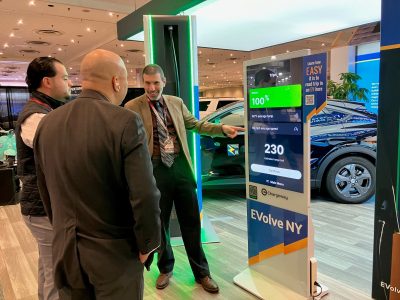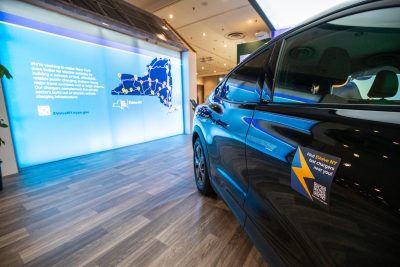Charging Forward and Electrifying New York Roadways
News Based on facts, either observed and verified directly by the reporter, or reported and verified from knowledgeable sources.
By Roger Witherspoon

The problem with electric vehicles is not one of style or utility.
Anyone strolling through the massive Jacob Javits Conference Center in Manhattan, which recently hosted the New York International Auto Show, can see a wide range of styles and uses for EVs.
Ford has the electric version of its iconic 60-year-old Mustang, the Mach-E. But it has to share the limelight with the Hyundai Ionic 5N, which won this year’s World Performance Car, Cadillac’s sedate Lyriq, Volkswagen’s ID-4, Lexus’ RZ, the mystic-sounding Lucid Air and others.
Rounding out the EV fleet are the buses, vans and trucks all running on various-sized batteries, all available for a test drive on an indoor track. It’s a stunning look at the possible near future.
But there is a problem facing governments seeking to move the mobile public from gasoline-powered cars to electric motors and manufacturers seeking to design and sell them. There are the joint questions of how far can the EVs travel on a charge and how accessible and timely are rechargers?
If you are driving some 400 miles from Westchester County to Buffalo, there are gas and refreshment stations conveniently located along all the state’s highways and main arteries. But most lack EV chargers. And when a motorist can find a charger, it may be a slow one, taking four to six hours to put the car back on the road. And there may be a car charging ahead of you, adding to the wait time. EVs are not likely to catch on unless the range anxiety issue goes away.
Which is where the New York Power Authority (NYPA) enters the picture. NYPA was established to provide low-cost electricity to municipal governments and school systems using its own power plants or purchasing it through government-run markets. Now, however, NYPA is providing a range of chargers throughout the state.
“We now have 170 chargers in 43 locations that are geographically dispersed,” said John Markowitz, NYPA’s director of e-mobility technology and engineering. “The goal is to get 400 in the next year and a half. That sounds like a lot, but the state is going to need over 6,000, and we are just a piece of the entire power puzzle because there were few companies doing this. There was next to nothing upstate, and getting the chargers around would give people incentive to buy electric-powered cars.”

Markowitz touched a point on a roadmap on a demonstration model of the state’s charging app and a dozen green dots lit up around his finger. These represented fast charging stations near that location.
“We want to have dots on all the major highways in the state,” he said, “just 50 miles apart so that it is practical to drive around the state with no worries about running out of power.
“When you’re traveling, you want to stop at a place where you have time to get gas, use the bathroom, get a sandwich, sit down and eat and then get back on the road. We want it to be that practical to drive around in an EV.”
NYPA, Markowitz said, consulted Google maps and power utility line surveys around the state to see what power sources were available to tap. The kind of electric charger that would go in a private home, for example, generally pushes six kilowatts and costs the homeowner around $500. It would take six to eight hours to charge the family car, but it is parked in the garage all night anyway.
A high-speed charger pushes 150 to 350kW, Markowitz said, and costs about $150,000. But the average car battery takes 75kW, while the average pickup truck takes 120kW. With the fast charger, you can refuel your car battery and leave in 20 minutes. That time frame, he said, is compatible with normal highway refueling stops for gas-powered cars.
Once NYPA has identified local power capabilities, they approach rest stop owners, such as Stewart’s, “and we ask if they are interested in having a group of up to 10 fast charging stations installed. And then we see if we have a partner or not,” Markowitz said.
NYPA pays all costs associated with building and providing the charging station, “and we pay them a small amount to shovel the snow around the charging stations,” he added. “We are bringing people into their store who will be buying sandwiches and ice cream, people who would not normally be stopping there. So having the charging station is good for them.”
NYPA is also targeting public and private bus companies to add both high speed and medium chargers to their depots, as well as municipal parking lots. NYPA’s program, called Evolve New York, is particularly important for bus depots.
“Transit agencies have a goal of having fully electric bus fleets by 2035,” explained Markowitz, an electrical engineer by training. “New York City’s metropolitan system has 5,700 buses and their goal is to be all electric by 2040 because of the enormity of their fleet. One of their depots can have 200 buses in it. That’s a lot of diesel engines starting up in the morning and returning in the night. Think of the air quality improvement by replacing them with electric-powered buses. That’s incredibly exciting since every year they are retiring about 10 percent of their fleet.”
Having a NYPA exhibit of maps next to an EV test track may seem a bit out of place at an auto show full of glistening new cars. But NYPA, which built and operated Indian Point 3 and provided electricity for the New York City subway system, has been active in electric transport for 30 years, said Markowitz, who began his engineering career working for a private firm that made parts for electric vehicles, from forklifts to wheelchairs.
“Back in the ‘90s,” Moskowitz recalled, “some of the car manufacturers ordered parts from us for prototypes of electric cars, and I got the bug back then. It was the direction you knew the world would have to go in for economic stability. It was a technology you knew had to come. It was just a question of when.”

Examiner Media – Keeping you informed with professionally-reported local news, features, and sports coverage.


